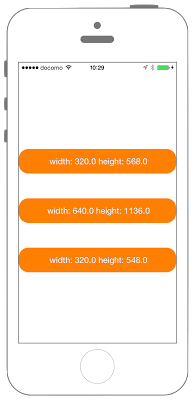画面サイズを取得する

Swift3.0
import UIKit
class ViewController: UIViewController {
var myLabel: UILabel!
override func viewDidLoad() {
super.viewDidLoad()
let myBoundSize: CGSize = UIScreen.main.bounds.size
let myBoundSizeStr: NSString = "Bounds width: \(myBoundSize.width) height: \(myBoundSize.height)"
print("\(myBoundSizeStr)")
setMyLabel(text: myBoundSizeStr, point: CGPoint(x: 0, y: 100))
let myNativeBoundSize: CGSize = UIScreen.main.nativeBounds.size
let myNativeBoundSizeStr: NSString = "NativeBounds width: \(myNativeBoundSize.width) \nNativeBoundheight: \(myNativeBoundSize.height)"
print("\(myNativeBoundSizeStr)")
setMyLabel(text: myNativeBoundSizeStr, point: CGPoint(x: 0, y: 200))
myLabel.font = UIFont.systemFont(ofSize: 14)
let myAppFrameSize: CGSize = UIScreen.main.bounds.size
let myAppFrameSizeStr: NSString = "applicationFrame width: \(myAppFrameSize.width) \nNativeBoundheight: \(myAppFrameSize.height)"
print("\(myAppFrameSizeStr)")
setMyLabel(text: myAppFrameSizeStr, point: CGPoint(x: 0, y: 300))
myLabel.font = UIFont.systemFont(ofSize: 14)
let myScale: CGFloat = UIScreen.main.scale
print("\(myScale)")
setMyLabel(text: "\(myScale)", point: CGPoint(x: 0, y: 400))
myLabel.font = UIFont.systemFont(ofSize: 20)
}
func setMyLabel(text: NSString, point: CGPoint){
myLabel = UILabel(frame: CGRect(x:point.x,y:point.y,width:self.view.bounds.width,height:50))
myLabel.backgroundColor = UIColor.orange
myLabel.layer.masksToBounds = true
myLabel.layer.cornerRadius = 10.0
myLabel.textColor = UIColor.white
myLabel.shadowColor = UIColor.gray
myLabel.textAlignment = NSTextAlignment.center
myLabel.text = text as String
myLabel.numberOfLines = 2
self.view.addSubview(myLabel)
}
}
Swift 2.3
import UIKit
class ViewController: UIViewController {
var myLabel: UILabel!
override func viewDidLoad() {
super.viewDidLoad()
let myBoundSize: CGSize = UIScreen.mainScreen().bounds.size
let myBoundSizeStr: NSString = "Bounds width: \(myBoundSize.width) height: \(myBoundSize.height)"
print("\(myBoundSizeStr)")
setMyLabel(myBoundSizeStr, point: CGPoint(x: 0, y: 100))
let myNativeBoundSize: CGSize = UIScreen.mainScreen().nativeBounds.size
let myNativeBoundSizeStr: NSString = "NativeBounds width: \(myNativeBoundSize.width) \nNativeBoundheight: \(myNativeBoundSize.height)"
print("\(myNativeBoundSizeStr)")
setMyLabel(myNativeBoundSizeStr, point: CGPoint(x: 0, y: 200))
myLabel.font = UIFont.systemFontOfSize(14)
let myAppFrameSize: CGSize = UIScreen.mainScreen().bounds.size
let myAppFrameSizeStr: NSString = "applicationFrame width: \(myAppFrameSize.width) \nNativeBoundheight: \(myAppFrameSize.height)"
print("\(myAppFrameSizeStr)")
setMyLabel(myAppFrameSizeStr, point: CGPoint(x: 0, y: 300))
myLabel.font = UIFont.systemFontOfSize(14)
let myScale: CGFloat = UIScreen.mainScreen().scale
print("\(myScale)")
setMyLabel("\(myScale)", point: CGPoint(x: 0, y: 400))
myLabel.font = UIFont.systemFontOfSize(20)
}
func setMyLabel(text: NSString, point: CGPoint){
myLabel = UILabel(frame: CGRectMake(point.x,point.y,self.view.bounds.width,50))
myLabel.backgroundColor = UIColor.orangeColor()
myLabel.layer.masksToBounds = true
myLabel.layer.cornerRadius = 10.0
myLabel.textColor = UIColor.whiteColor()
myLabel.shadowColor = UIColor.grayColor()
myLabel.textAlignment = NSTextAlignment.Center
myLabel.text = text as String
myLabel.numberOfLines = 2
self.view.addSubview(myLabel)
}
}
2.3と3.0の差分
- UIColorの参照方法が変更(UIColor.grayColor()->UIColor.gray)
- CGRect,CGPointの初期化方法の変更(CGRectMake,CGPointMakeの廃止)
UIScreen.mainScreen()がUIScreen.mainに変更
Reference
